From her love affairs to her racy depiction in a semi-nude sculpture, Pauline Bonaparte lived a colorful and controversial life — especially for a woman of her rank.
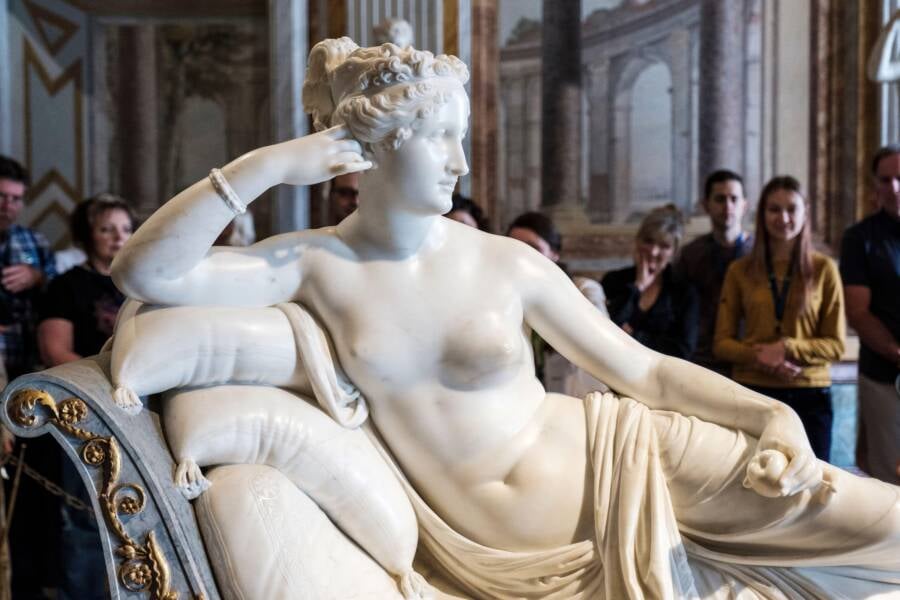
Rubens Alarcon/Alamy Stock PhotoThe famous semi-nude sculpture Pauline Bonaparte as Venus Victrix by Antonio Canova.
Hewn from white marble, Pauline Bonaparte reclines half-dressed on a settee, arm languidly supporting a noble head with elegant hair. Her posture and face show a level of pride befitting a depiction of Venus Victrix. The statue depicts someone Napoleon Bonaparte described as “the most beautiful woman of her time” and “the best of living creatures.”
Pauline, Napoleon’s favorite sister and one of the most fascinating Bonaparte siblings, was widely known across France and beyond for both her breathtaking beauty and her scandalous love affairs.
While most women in the late 18th and early 19th centuries would do anything to avoid such a reputation, Pauline seemed to embrace her celebrity — even when she courted controversy.
The Early Life Of Pauline Bonaparte
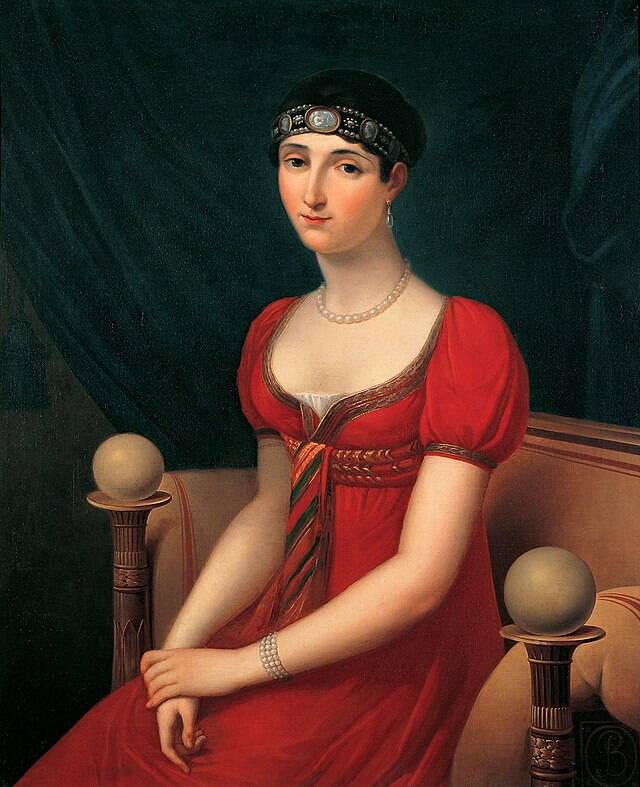
Napoleonic Museum/Wikimedia CommonsA painting of Napoleon Bonaparte’s sister Pauline.
Pauline Bonaparte was born on Oct. 20, 1780 in Ajaccio, Corsica. Her parents were Carlo Bonaparte and Maria Letizia Bonaparte, minor Corsican nobility who sided with France as Corsica shifted away from Genoa’s control.
Letizia was said to be a very strict and stern mother. Carlo worked as a lawyer, but Napoleon later said his father was “too fond of pleasure.”
Pauline, the sixth of eight children, would seem to inherit this trait.
She and Napoleon did not spend much time living in the same household, especially since Napoleon was sent to military school on the mainland. Eventually, Carlo fell ill, and died of stomach cancer in 1785.
The loss of the head of the household, as well as Napoleon’s public opposition of Corsica’s governor, made it dangerous for the Bonapartes to stay in their homeland. They fled the island in 1793 for the south of France.
The Rise Of The Bonaparte Family
At first, the Bonapartes fell far from their place of minor privilege in Corsica, becoming impoverished in Marseille, with some whispers that the female Bonapartes took in laundry and washed it in a public fountain to make ends meet. The family’s period of misfortune would not last long, though.
Napoleon was quickly making a name for himself in the military thanks to his tactical genius and notable ambition. He worked his way through the ranks from major to general to commander in chief. His exploits took him to places like Italy, Malta, and Egypt, his influence growing along the way.
He became the First Consul of France by the age of 30. And then, in 1804, the former nobody from Corsica crowned himself the Emperor of France.
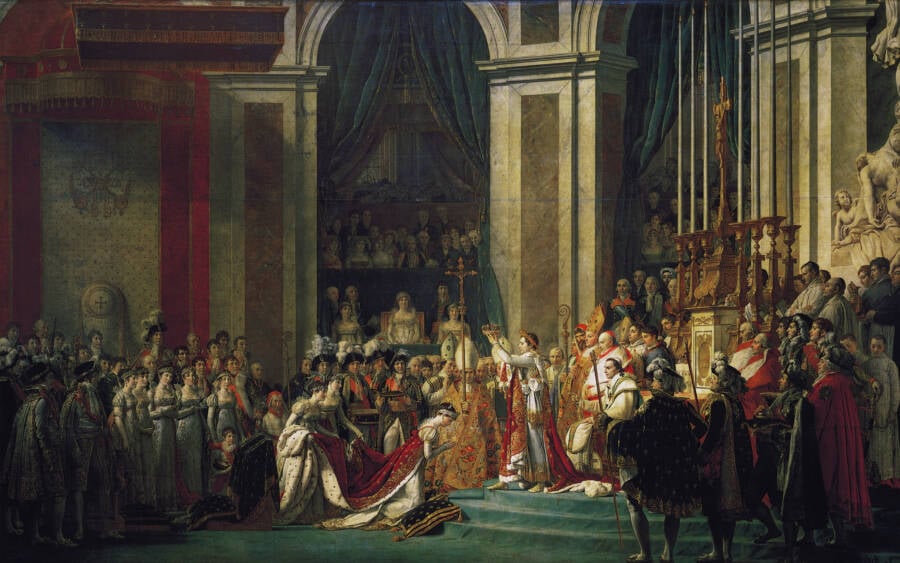
Louvre Museum/Wikimedia CommonsThe Coronation of Napoleon by Jacques-Louis David.
Meanwhile, Pauline had blossomed into a beautiful young maiden, who was known to socialize with many of her brother’s comrades.
Napoleon disapproved of many of Pauline’s relationships, and she eventually agreed to marry a man who Napoleon trusted, the French general Charles Leclerc, in 1797. About a year later, Pauline gave birth to the couple’s only child Dermide (who would later die at the age of just six).
The end of her maidenhood was just the beginning for Pauline, whose reputation in scandal nearly matched her brother’s in politics.
Pauline Bonaparte’s Reign In Saint-Domingue
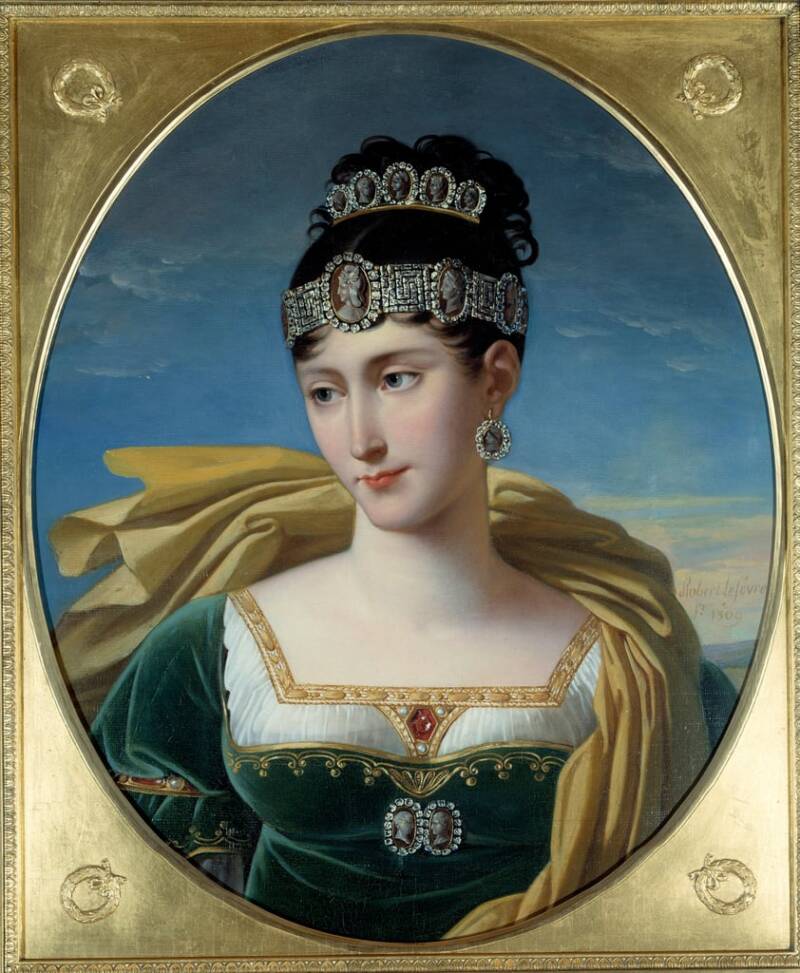
Lefèvre Robert/Wikimedia CommonsPauline enjoyed countless parties and alleged affairs while in the French colony of Saint-Domingue.
Despite a fondness for the glamour of Paris, Pauline found herself accompanying her husband to Saint-Domingue (present-day Haiti) in 1801. Then a French colony, Saint-Domingue produced much of the sugar and coffee imported by Europe, on the backs of enslaved workers.
In history’s first successful slave revolt, a former slave turned revolutionary leader named Toussaint Louverture led the colony’s Black populace to demand the end of slavery and independence from France.
In response, Napoleon sent his brother-in-law and about 20,000 other soldiers off to the Caribbean to suppress the revolt in Saint-Domingue.
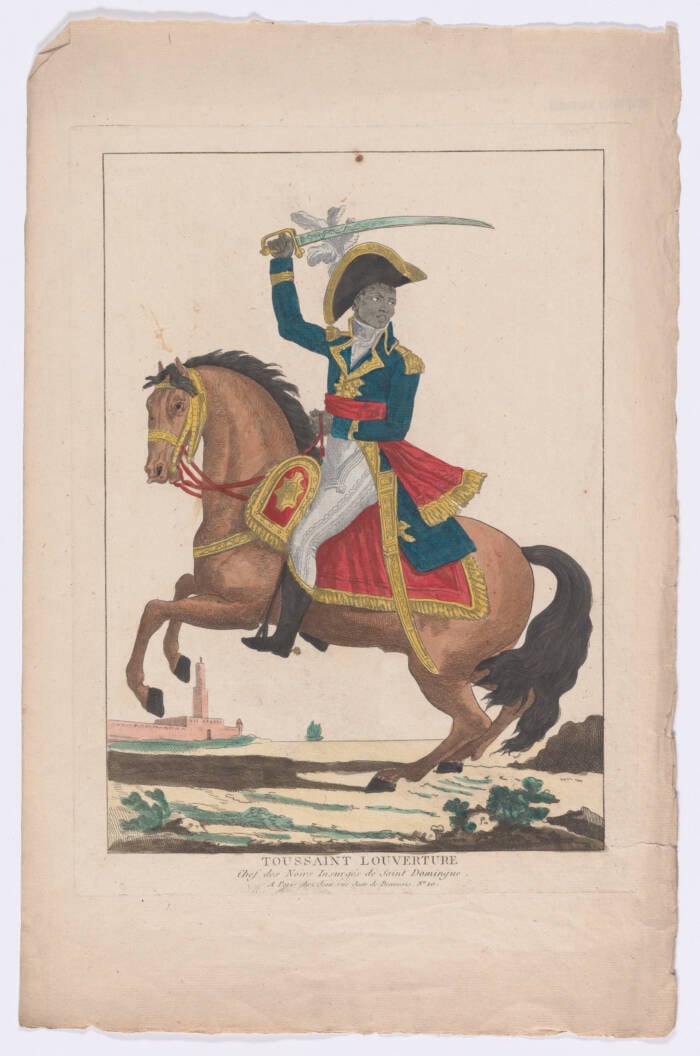
The Metropolitan Museum of Art/Wikimedia CommonsToussaint Louverture was a former slave who became a leader of the Haitian independence movement.
Despite Pauline’s initial reluctance to relocate, even temporarily, she ended up enjoying her time in the French colony immensely. While Leclerc commanded his army and saw countless soldiers die of yellow fever, Pauline fashioned herself the belle of colonial society, enjoying numerous parties on the island. She also purportedly had affairs with low-ranking soldiers.
As always, Pauline relished the proximity to power, declaring, “Here, I reign like Joséphine — I am the first lady in the land.” That said, her life there wasn’t all fun and games. She also showed compassion to people who had fallen ill, treating them in a makeshift field hospital she set up at her home.
Eventually, Leclerc contracted the dreaded yellow fever, and he died in 1802. Widowed at just 22, Pauline Bonaparte was to have a second renaissance.
From Widow To Princess Consort
Pauline Bonaparte put on an extravagant display of grief after her husband’s death — but only for as long as protocol required her to do so. Before long, she returned to France, where she picked up the habits of a merry widow.
She was known to spend lavishly on jewels and dresses, some of which were shockingly sheer and exposed her nipples. Referring to her good looks as “natural advantages,” she focused on maintaining her beauty as long as possible, reportedly bathing in milk to “preserve her white skin.”
Pauline clearly caught the attention of many men, including the actor François-Joseph Talma, with whom she shared a brief relationship. Unsurprisingly, gossip spread across France about Pauline’s behavior.
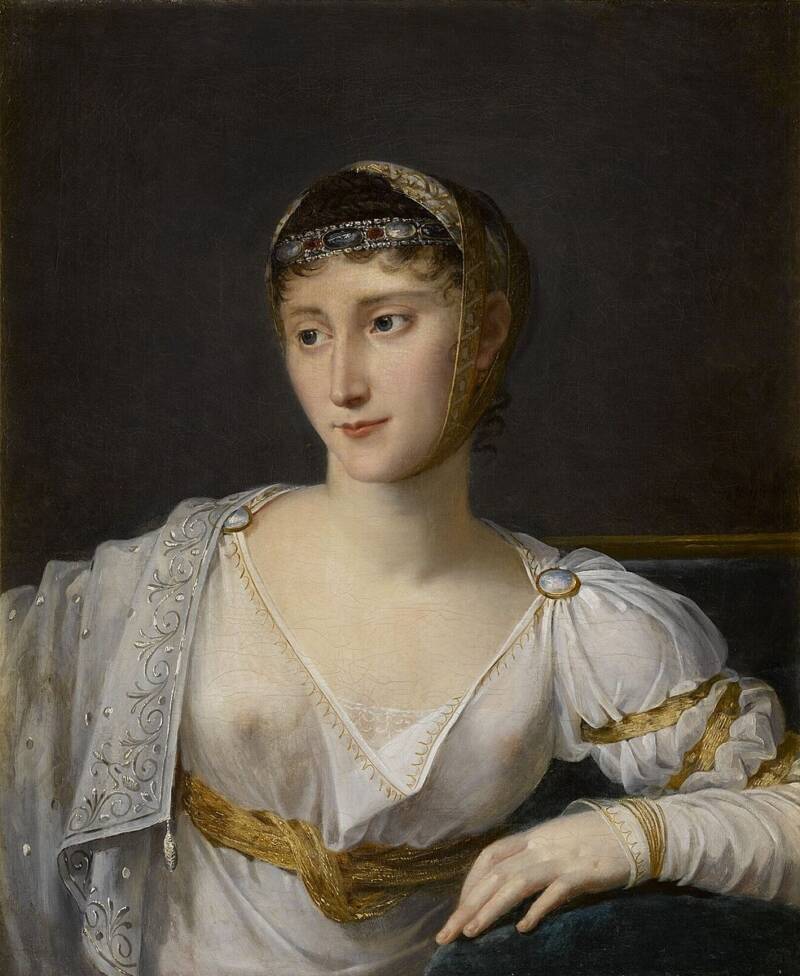
Palace Of Versailles/Wikimedia CommonsRumor has it that Pauline ordered her male servants to carry her naked to the bath.
Napoleon still adored his younger sister, but he was also growing tired of her whirlwind of scandals and romances in Paris.
Determined to set her up with Prince Camillo Borghese in Italy so that she could get married and settle down (and not damage his own reputation in Paris), he ordered her: “Leave then for Rome. Distinguish yourself by your gentleness, your kindness to everyone and your extreme consideration for the ladies who are relatives and friends of your husband’s household. Conform to the customs of the country, never despise anything, find everything beautiful, do not say ‘in Paris, there is better than that.'”
After marrying Camillo Borghese — less than a year after her first husband’s death — she became a princess consort of Sulmona and Rossano.
Pauline Bonaparte’s Life In Italy
Unlike her time in the Caribbean, Pauline’s life in Rome was no paradise. Losing her young son, and married to a man with alleged impotence, she found comfort in the arms of a lover, the noble painter Auguste de Forbin.
The two briefly ran away together to France, only ending their affair when Napoleon offered the artist the title of Baron of the Empire.
Reproaching his sister, Napoleon chided: “If you persist in leading this type of life, don’t count on me. I will not receive you again until you have ceased the disagreements with your husband. Come to an agreement with the prince and try to live worthy of my name and your lineage.”
Pauline did not listen to her brother. Italy proved rich ground for love affairs, ranging from conductors to military men, and for a greater love: that of art.
Eventually, she was immortalized in a semi-nude sculpture titled Pauline Bonaparte as Venus Victrix, created by the renowned artist Antonio Canova. Her nude torso was sculpted in the neo-classically idealized female form, but rumor has it that she actually posed nude for the artist.
Canova had purportedly worried about the sculpture causing scandal, especially since Pauline was such a high-ranking woman. At one point, he suggested to Pauline that he depict her as a virgin goddess instead, but Pauline allegedly replied, “Nobody would believe my chastity.”
The End Of An Empire: Napoleon And Pauline Bonaparte’s Final Days
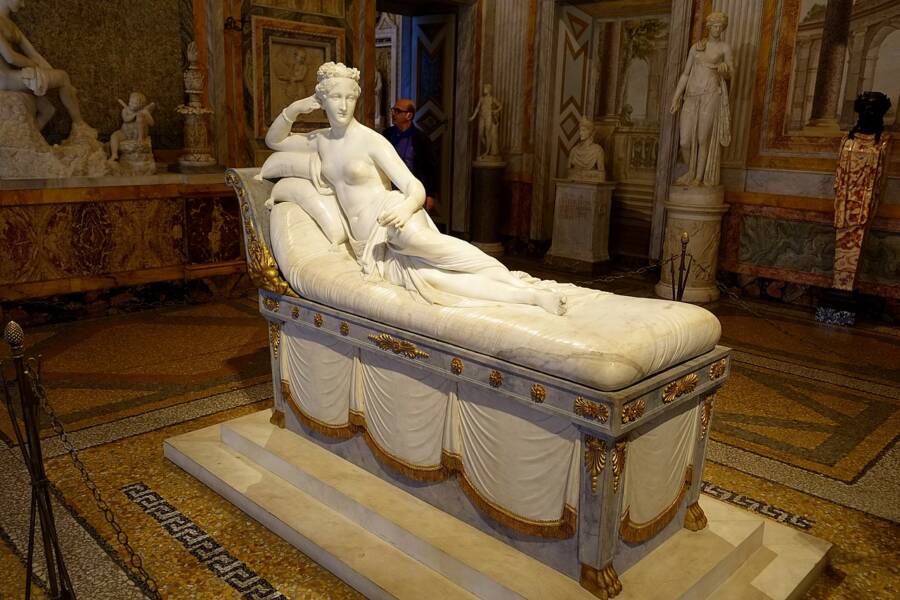
Galleria Borghese/Wikimedia CommonsIn response to the buzz that the famous Pauline Bonaparte as Venus Victrix sculpture generated, the princess consort coyly remarked, “One may let every veil fall in front of Canova.”
Though Pauline Bonaparte as Venus Victrix is far from the only depiction of her, it is by far the most recognizable and the most symbolic of her life. Indeed, Pauline embodies the goddess of love in triumph.
While she may have garnered infamy while she was alive for cheating on her romantic partners and indulging in her material desires, she was also known to be fiercely loyal to her brother Napoleon — even after he was forced to abdicate his throne following a series of poor military decisions.
She visited him on Elba during his first exile (the only one of his siblings to do so), and traded Borghese diamonds to fund his last stand at Waterloo. The emperor was dethroned definitively in 1815, and died in exile in 1821.
Pauline Bonaparte died of cancer at age 44 on June 9, 1825. By then, she had been reunited with her estranged husband with the help of the pope.
Napoleon’s legacy is a complex one of domination and development. Pauline’s is less consequential, but she leaves behind a storied life lived on her own terms, despite being constantly defined by the men around her and the power of her beauty. She also leaves behind a splendid masterpiece.
Next, go inside the opulent lifestyle of Marie Antoinette, France’s beheaded queen. Then, discover some fascinating facts about France.





